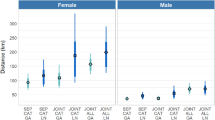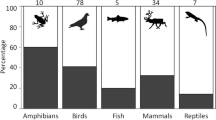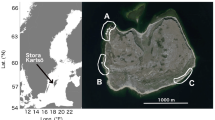Abstract
The relative contribution of in situ reproduction versus immigration to the recruitment process is important to ecologists. Here we consider a robust design superpopulation capture-recapture model for a population with two age classes augmented with population assignment data. We first use age information to estimate the entry probabilities of new animals originating via in situ reproduction and immigration separately for all except the first period. Then we combine age and population assignment information with the capture-recapture model, which enables us to estimate the entry probability of in situ births and the entry probability of immigrants separately for all sampling periods. Further, this augmentation of age specific capture-recapture data with population assignment data greatly improves the estimators’ precision. We apply our new model to a capture-recapture data set with genetic information for banner-tailed kangaroo rats in Southern Arizona. We find that many more individuals are born in situ than are immigrants for all time periods. Young animals have lower survival probabilities than adults born in situ. Adult animals born in situ have higher survival probabilities than adults that were immigrants.


Similar content being viewed by others
References
Crosbie SF, Manly BFJ (1985) Parsimonious modeling of capture-mark-recapture studies. Biometrics 41:385–398
Devillard S, Bray Y (2009) Assessing the effect on survival of natal dispersal using multistate capture-recapture models. Ecology 90:2902–2912
Doligez B, Pärt T (2008) Estimating fitness consequnces of dispersal: a road to ‘know-where’? Non random dispersal and the underestimation of dispersers fitness. J Anim Ecol 77:1199–1211
Favre L, Balloux F, Goudet J, Perrin N (1997) Female biased dispersal in the monogamous mammal Crocidura russula: evidence from field data and microsatellite patterns. Proc R Soc Lond Ser B 264:127–132
Hanski I (1999) Metapopulation ecology. Oxford University Press, UK
Hobson KA (1999) Tracing origins and migration of wildlife using stable isotopes: a review. Oecologia 120:324–326
Guinand B, Topchy A, Page KS, Burnham-Curtis MK, Punch WF, Scribner KT (2002) Comparisons of likelihood and machine learning methods of individual classification. J Hered 93:260–269
Jolly GM (1965) Explicit estimates from capture-recapture data with both death and immigration-stochastic model. Biometrika 52:225–247
Jones WT (1986) Density-related changes in survival of philopatric and dispersing kangaroo rats. Ecology 69:1474–1478
Kendall WL, Pollock KH (1992) The robust design in capture-recapture studies: a review and evaluation by Monte Carlo simulation. In: McCullough DR, Barrett RH (eds) Wildlife 2001: populations. Elsevier, London
Kendall WL, Nichols JD (1995) On the use of secondary capture-recapture samples to estimate temporary emigration and breeding proportions. J Appl Stat 22:751–762
Kendall WL, Nichols JD, Hines JE (1997) Estimating temporary emigration using capture-recapture data with Pollock’s robust design. Ecology 78:563–578
Manel S, Gaggiotti OE, Waples RS (2005) Assignment methods: matching biological questions with appropriate techniques. Trends Ecol Evol 20:136–142
Moilanen A, Wilson KA (2009) Spatial conservation prioritization. Oxford University Press, UK
Nichols JD, Pollock KH (1990) Separate estimation of recruitment from immigration versus in situ reproduction using Pollock’s robust design. Ecology 71:21–26
Paetkau D, Calvert W, Stirling I, Strobeck C (1995) Microsatellite analysis of population structure in Canadian polar bears. Mol Ecol 4:347–354
Piry S, Alapetite A, Cornuet J-M, Paetkau D, Baudouin L, Estoup A (2004) GeneClass2: a software for genetic assignment and first-generation migrant detection. J Hered 95:536–539
Pollock KH, Nichols JD, Brownie C, Hines JE (1990) Statistical inference for capture-recapture experiments. Wildl Monogr
Pollock KH (1982) A capture-recapture design robust to unequal probability of capture. J Wildl Manag 46:757–760
Pulliam RH (1988) Sources sinks, and population regulation. Am Nat 132:652–661
Rubin DB (1987) Multiple imputation for nonresponse in surveys. Wiley, New York
Runge JP, Runge MC, Nichols JD (2006) The role of local populations within a landscape context: defining and classifying sources and sinks. Am Nat 167:925–938
Sanderlin JS, Waser PM, Hines JE, Nichols JD (2012) On valuing patches: estimating contributions to metapopulation growth with reverse-time capture-recapture modeling. Proc R Soc (Lond) B 279: 480–488
Schwarz CJ, Arnason AN (1996) A general methodology for the analysis of capture-recapture experiments in open populations. Biometrics 52:860–873
Schwarz CJ, Arnason AN (2000) Estimation of age-specific breeding probabilities from capture-recapture data. Biometrics 56:59–64
Seber GAF (1965) A note on the multiple recapture census. Biometrika 52:249–259
Seber GAF (1982) The estimation of animal abundance and related parameters, 2nd edn. Charles Griffin, London
Skvarla JL, Nichols JD, Hines JE, Waser PM (2004) Modeling interpopulation dispersal by banner-tailed kangaroo rats. Ecology 85:2737–2746
Waser PM, Hadfield JD (2010) How much can parentage assignment tell us about interpopulation movement? Mol Ecol 20:1277–1288
Waser PM, Busch J, McCormick CR, DeWoody JA (2006) Parentage analysis detects cryptic precapture dispersal in a philopatric rodent. Mol Ecol 15:1929–1937
Waser PM, Strobeck C (1998) Genetic signatures of interpopulation dispersal. Trends Ecol Evol 13:43–44
Wen Z, Pollock KH, Nichols JD, Waser PM (2011) Augmenting superpopulation capture-recapture models with population assignment data. Biometrics 67:691–700
Acknowledgments
We thank the NSF, for support (DEB 0816925).
Author information
Authors and Affiliations
Corresponding author
Additional information
Handling Editor: Ashis SenGupta.
Rights and permissions
About this article
Cite this article
Wen, Z., Nichols, J.D., Pollock, K.H. et al. A robust design capture-recapture model with multiple age classes augmented with population assignment data. Environ Ecol Stat 21, 41–59 (2014). https://doi.org/10.1007/s10651-013-0243-6
Received:
Published:
Issue Date:
DOI: https://doi.org/10.1007/s10651-013-0243-6




